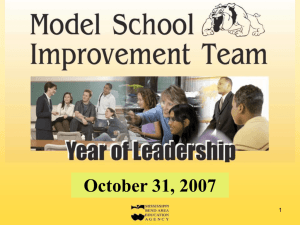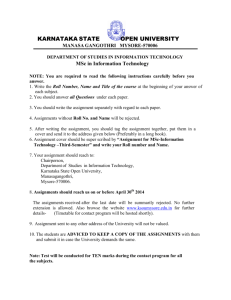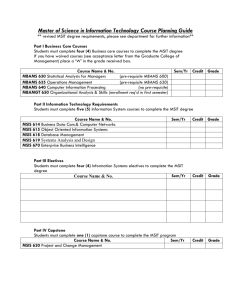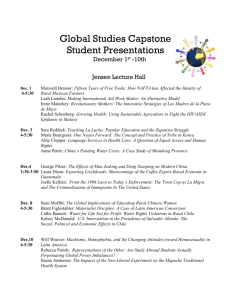What is
advertisement
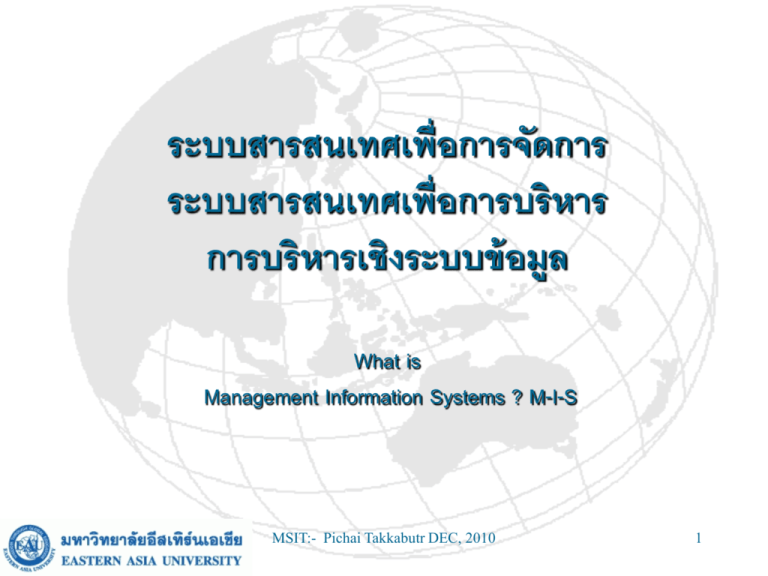
ระบบสารสนเทศเพื่อการจัดการ ระบบสารสนเทศเพื่อการบริหาร การบริหารเชิงระบบข้ อมูล What is Management Information Systems ? M-I-S MSIT:- Pichai Takkabutr DEC, 2010 1 Definition of Management Information System IS:ระบบสารสนเทส เพื่อ การจัดการ (บรรยาย อธิบาย พยากรณ์ และควบคุม) 1. For providing information พึ่งพาทรัพย์ สินทางปั ญญาสารสนเทศ ค้ นหาจากระบบธรรมชาติส่ งิ แวดล้ อม REAL SECTOR/ ANALOG 2. Integrated man-machine system พึ่งพาอัตโนมัติ ให้ กับ คน และ ธรรมชาติส่ ิงแวดล้ อม อยู่รอด ยั่งยืน ICT SECTOR/ DIGITAL 3. To support operations, management, analysis and decision making functions of an organization (All of Activities and Functions of Information Processors) แก้ ไขปั ญหาของคนด้ วยปั ญญาเทียม/ ปั ญญา ประดิษฐ VIRTUAL SECTOR/ WORLD MSIT:- Pichai Takkabutr DEC, 2010 2 MIS is Integrated man-machine system 1. MAN is People Ware/ PW :• Computer Man/ Technician:- CIO, System Analyst, System Engineer, System Programmer, Data Admin / ADMIN, Operators, Data Entry Operator etc; • Users:- EP, EVP, CEO, CCO, CFO, Computing User, USER, Client/ Customer, Executive, BOSS etc; 2. MACHINE is ICT/ IT/ ECTI/ E/ Computer/ NETWORK/ Technology INFRASTRUCTURE of HARDWARE/ HW and SOFTWARE/ SW 3. SYSTEMS Integrated is KNOW-HOW/ Explicit Knowledge and KNOW-WHY/ TACIT Knowledge interdisciplinary/ SOCIO-cultural INNOVATION/ SOCIO Technology/ APPLICAIONS (METAPHYSICS/ ONTOLOGY/ EPISTERMOLOGY) MSIT:- Pichai Takkabutr DEC, 2010 3 MIS For providing information 1. Types of Information Impact/ Feed Back from • • • Activities and Functions of Information Processors Based on Activities VS. DSS:- Structured, Unstructured, Semi-structured:- SISP. MIS, TPS Based on Functions VS. GDSS:- Both Front Office and Back Office:- Production, Marketing, Trading, Service, Consumption, Financial Based on Internal Information VS. ERP, External Information VS. SCM, CRM, DCM 2. Information sub_systems:- TPS, EDPS, OAS, MIS, EIS. ES MSIT:- Pichai Takkabutr DEC, 2010 4 MIS To support operations, management, analysis and decision making functions In an organization (All of Activities and Fuctions of Information Processors) 1. Target Gropus • Shareholders/ Stock Holders • Stakeholders 2. Activities of Target Groups • Strategy/ Top Management:- SISP • Tactical/ Management/ Middle Management:- MIS/ Information Center, KB Center • Operating Management:- Network Centric Operation/ NCO 3. Function/ All of Applications:- Interdisciplinary MSIT:- Pichai Takkabutr DEC, 2010 5 1 Foundations of Information Systems in Business MSIT:- Pichai Takkabutr DEC, 2010 6 1 Learning Objectives • Explain why knowledge of information systems is important for business professionals and identify five key areas of information systems knowledge. • Give examples to illustrate how the business applications of information systems can support a firm’s business processes, managerial decision making, and strategies for competitive advantage. MSIT:- Pichai Takkabutr DEC, 2010 7 1 Learning Objectives (Continued) • Provide examples of the components of real world information systems. • Provide examples of several major types of information systems. • Identify several challenges that a business manager might face in managing the successful and ethical development and use of information technology in a business. MSIT:- Pichai Takkabutr DEC, 2010 8 1 Information Systems Framework MSIT:- Pichai Takkabutr DEC, 2010 9 1 Information Systems Concepts (Continued) • Foundation Concepts – Fundamental concepts about the components and roles of information systems. • Information Technologies – Major concepts, developments, and management issues in information technology. MSIT:- Pichai Takkabutr DEC, 2010 10 1 Information Systems Concepts (Continued) • Business Applications – The major uses of information systems for operations, management, and competitive advantage. • Development Processes – How business professionals and information specialists plan, develop, and implement information systems. • Management Challenges – The challenge of managing ethically and effectively. MSIT:- Pichai Takkabutr DEC, 2010 11 1 What IS a system? • A group of interrelated or interacting elements forming a unified whole, OR • A group of interrelated components working together toward a common goal by accepting inputs and producing outputs in an organized transformation process (dynamic system). • Three basic interacting components: – Input – Processing (transformation process) – Output MSIT:- Pichai Takkabutr DEC, 2010 12 1 Add Feedback and Control Loops.. • And the system, now called a cybernetic system, becomes even more useful. – Self-monitoring – Self-regulating MSIT:- Pichai Takkabutr DEC, 2010 13 1 Other System Characteristics • A system exists and functions in an environment containing other systems. • Subsystem – a component of a larger system. • Systems that share the same environment may be connected to one another through a shared boundary, or interface. • Open versus closed system. • Adaptive system MSIT:- Pichai Takkabutr DEC, 2010 14 1 Components of an INFORMATION System MSIT:- Pichai Takkabutr DEC, 2010 15 1 Components of an Information System (Continued) • People Resources – End Users – IS Specialists • Hardware Resources – Computer systems – Peripherals • Software Resources – System software – Application software – Procedures MSIT:- Pichai Takkabutr DEC, 2010 16 1 Components of an Information System (Continued) • Data Resources – Data versus Information • Network Resources – Communication media – Network support MSIT:- Pichai Takkabutr DEC, 2010 17 1 Data Versus Information Monthly Sales Report for West Region Sales Rep: Charles Mann Emp No. 79154 Item Qty Sold Price TM Shoes 1200 $100 MSIT:- Pichai Takkabutr DEC, 2010 18 1 Attributes of Information Quality MSIT:- Pichai Takkabutr DEC, 2010 19 1 Logical Data Elements Name Field Payroll Record Payroll File Personnel Database MSIT:- Pichai Takkabutr DEC, 2010 20 1 Information Products • Focus is on the end-user. • They are the result of IS activities… – – – – – Input Processing Output Storage Control MSIT:- Pichai Takkabutr DEC, 2010 21 1 Section II • Foundation Concepts: Business Applications, Development, and Management MSIT:- Pichai Takkabutr DEC, 2010 22 1 Major Roles of IS Support Competitive Advantage Support Business Decision Making Support of Business Processes and Operations MSIT:- Pichai Takkabutr DEC, 2010 23 1 Major Roles of IS (continued) • Support Business Processes • Support Decision Making • Support Competitive Advantage MSIT:- Pichai Takkabutr DEC, 2010 24 1 The Present and the Future • E-Business – The use of Internet technologies to internet work and empower… • Business processes • Electronic commerce, and • Enterprise communication & collaboration – Within a company & with its customers, suppliers, & other business stakeholders. MSIT:- Pichai Takkabutr DEC, 2010 25 1 IS in the E-Business Enterprise • Every business competes globally (whether they realize it or not) • IS supports business operations through the use of: – – – – Intranets Extranets Internet Other information technologies MSIT:- Pichai Takkabutr DEC, 2010 26 1 IS in the E-Business Enterprise (continued) • Enterprise Collaboration Systems – Support communication, coordination, & collaboration. • Virtual teams • Electronic Commerce – Buying & selling, and marketing & servicing of products, services, & information. MSIT:- Pichai Takkabutr DEC, 2010 27 1 Trends in Information Systems MSIT:- Pichai Takkabutr DEC, 2010 28 Orasa T. 1 Types of Information Systems • Operations Support Systems – Transaction processing systems • Batch – transaction data accumulate over time, processed periodically. • Real-time – data processed immediately after a transaction occurs. – Process Control Systems – monitor & control physical processes. – Enterprise Collaboration Systems MSIT:- Pichai Takkabutr DEC, 2010 29 Orasa T. 1 Types of Information Systems (continued) • Management Support Systems – Management Information Systems – prespecified reports & displays to support decision-making. – Decision Support Systems – provide interactive ad hoc support. – Executive Information Systems – critical information tailored to the information needs of executives. MSIT:- Pichai Takkabutr DEC, 2010 30 1 Types of Information Systems (continued) • Other Classifications – Expert systems – expert advice – Knowledge management systems – support the creation, organization, & dissemination of business knowledge – Functional business systems – support the basic business functions – Strategic information systems – strategic advantage MSIT:- Pichai Takkabutr DEC, 2010 31 1 Developing IS Solutions to Business Challenges MSIT:- Pichai Takkabutr DEC, 2010 32 1 Ethical Challenges • Just because we can, should we? • Where do we draw the line between customer privacy and collecting business information? • Do we owe it to society to use this technology wisely and responsibly? Why? Isn’t our job to make a profit? MSIT:- Pichai Takkabutr DEC, 2010 33 1 In Summary, the IS Function… • Is a major functional area of business. • Is an important contributor to operational efficiency, employee productivity and morale, and customer service & satisfaction. • Is a major source of information and support for decision making. • Provides a strategic advantage in developing competitive products & services. MSIT:- Pichai Takkabutr DEC, 2010 34 1 Discussion Questions • How can information technology support a company’s business processes and decision making, and give it a competitive advantage? • How does the use of the Internet, intranets, and extranets by an e-business enterprise support their ecommerce activities? • Why do big companies still fail in their use of information technology? What should they be doing differently? MSIT:- Pichai Takkabutr DEC, 2010 35 1 Discussion Questions (continued) • How can a manager demonstrate that he or she is a responsible end user of information systems? • What are some of the toughest management challenges in developing IT solutions to solve business problems and meet new e-business opportunities? • Why are there so many conceptual classifications of information systems? Why are they typically integrated in information systems found in the real world? MSIT:- Pichai Takkabutr DEC, 2010 36 1 Discussion Questions (continued) • In what major ways have the roles of information systems applications in business expanded during the last 40 years? What is one major change you think will happen in the next 10 years? • Can the business use of Internet technologies help a company gain a competitive advantage? MSIT:- Pichai Takkabutr DEC, 2010 37 1 References • James A. O'Brien; George M. Marakas. Management Information Systems: Managing Information Technology in the Business Enterprise 6th Ed., Boston: McGraw-Hill/ Irwin,2004 MSIT:- Pichai Takkabutr DEC, 2010 38 Information Systems • Information Systems are becoming the foundation of business models and processes • They allow for the distribution of knowledge MSIT:- Pichai Takkabutr DEC, 2010 39 IT and IS • What is Information Technology? – Any form of technology used by people to handle information. • What are Information Systems? – Integrated components processing, storing and disseminating information in an organisation. – Interdisciplinary study of systems that provide information to users in organisations. Pyle, I.C. & Illingworth, V. (Eds) (1996). Oxford Dictionary of Computing, 4 th Edition. Oxford / New York: Oxford University Press MSIT:- Pichai Takkabutr DEC, 2010 40 Information and Data • Information – Clusters of facts meaningful and useful to human beings in processes such as making decisions • Data – Streams of raw facts representing events such as business transactions – meaningless without structure MSIT:- Pichai Takkabutr DEC, 2010 41 Experiences of IT and IS • Examples of IT – Hardware (PC, UNIX server) – Software (e-mail, Internet, Windows, Word) – Consumer devices (mobiles, train times) • Examples of IS – File systems, databases, e-mail servers / clients – e-commerce – SAP, student records MSIT:- Pichai Takkabutr DEC, 2010 42 Management Information Systems • MIS – The study of information systems focusing on their use in business and management. • Approaches – Technical – Behavioural – Sociotechnical MSIT:- Pichai Takkabutr DEC, 2010 43 Approaches to IS TECHNICAL APPROACHES COMPUTER OPERATIONS SCIENCE RESEARCH MANAGEMENT SCIENCE MIS SOCIOLOGY PSYCHOLOGY POLITICAL SCIENCE MSIT:- Pichai Takkabutr DEC, 2010 BEHAVIORAL APPROACHES SOCIOTECHNICAL 44 Why is IS Important? • For an organisation to survive and prosper – More locations (networking, Internet) – New products and services – Improve jobs and work flows: • Efficiency • Cost • Ethical and social issues MSIT:- Pichai Takkabutr DEC, 2010 45 Why is IS Important? • Worldwide changes: – – – – Global economy Knowledge- or information-based society Business enterprise Digital firm MSIT:- Pichai Takkabutr DEC, 2010 46 Global Economy • Growing percentage of economy relies upon import and export • Need to operate globally • IS can provide global trading infrastructure MSIT:- Pichai Takkabutr DEC, 2010 47 Information Economy 70% 60% % SERVICE 50% % WHITE COLLAR 40% % BLUE COLLAR 30% % FARMING 20% 10% 0% YEAR MSIT:- Pichai Takkabutr DEC, 2010 48 Changes to Society • Change of employment profiles: – – – – Less farming Less ‘blue collar’ – manufacturing Increased service Increased ‘white collar’ – office-based • USA: 55% of work force are in knowledgeor information-based activities • Shift of manufacture to low-wage countries MSIT:- Pichai Takkabutr DEC, 2010 49 Business Enterprise • • • • Change from hierarchical organisations Now flat, decentralised Relies on instant information Flexibility with customer focus, with increasing importance MSIT:- Pichai Takkabutr DEC, 2010 50 Digital Firm • An organisation where: – Nearly all relationships with customers, suppliers and employees is digital – Business processes accomplished through digital networks • Flexible • Dependent upon on IT MSIT:- Pichai Takkabutr DEC, 2010 51 Course Objectives • Provide an understanding of – – – – IS and underlying IT Impact on organisations of IS Implementation and management of IS IS and global organisations • Provide awareness of IS in your role as a professional MSIT:- Pichai Takkabutr DEC, 2010 52 Course Content • Information Systems in an Organisation • Information Systems, Organisations, Management and Strategy • Enhancing Management Decision Making • Managing Data and Information • Redesigning the Organisation with Information Systems and Managing Change MSIT:- Pichai Takkabutr DEC, 2010 53 Course Content • Electronic Commerce and the Internet • Information Systems Security and Control • Managing International Information Systems • Managing Assets MSIT:- Pichai Takkabutr DEC, 2010 54 Tutorials • Three case studies over semester – Information systems, organisations and decision support – Changing organisations – International organisations and the Internet MSIT:- Pichai Takkabutr DEC, 2010 55 Assessment • One piece of individual course-work – – – – 40% of module Case study report Set in week 1 Due beginning week 12 (Monday by 5:00pm) • Exam – 60% of module MSIT:- Pichai Takkabutr DEC, 2010 56 Text Book • Haag, Cummings, McCubbrey (2004). Management Information Systems for the Information Age, 4th Edition. McGraw Hill. • Turban, McLean, Wetherbe (1999). Information Technology for Management, 2nd Edition. John Wiley & Sons. Inc. • Laudon, K.C. & Laudon, J.P. (2002). Management Information Systems: Managing the Digital Firm, 7th Edition. Upper Saddle River, New Jersey: Prentice-Hall International, Inc. MSIT:- Pichai Takkabutr DEC, 2010 57 Topics Topic Introduction 1 Information Systems in an Organisation 2, 11.1 Information Systems, Organisations, Management and Strategy 3 Enhancing Management Decision Making 13 Managing Data and Information 7, 12 Redesigning the Organisation with Information Systems and Managing Change 10, 11.2/3 Electronic Commerce and the Internet 4, 8, 9 Information Systems Security and Control 14 Managing International Information Systems 16 Managing Assets 5, 6 MSIT:- Pichai Takkabutr DEC, 2010 58 Case Study Planning a New Internet Business MSIT:- Pichai Takkabutr DEC, 2010 59
